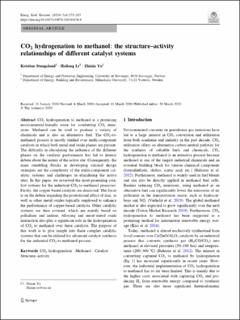| dc.contributor.author | Stangeland, Kristian | |
| dc.contributor.author | Li, Hailong | |
| dc.contributor.author | Yu, Zhixin | |
| dc.date.accessioned | 2021-02-15T10:36:28Z | |
| dc.date.available | 2021-02-15T10:36:28Z | |
| dc.date.created | 2020-07-27T09:12:11Z | |
| dc.date.issued | 2020-03 | |
| dc.identifier.citation | Stangeland, K., Li, H., Yu,Z. (2020) CO2 hydrogenation to methanol: the structure–activity relationships of different catalyst systems. Energy, Ecology and Environment, 5, 272-285. | en_US |
| dc.identifier.issn | 2363-7692 | |
| dc.identifier.uri | https://hdl.handle.net/11250/2728023 | |
| dc.description.abstract | CO2 hydrogenation to methanol is a promising environmental-friendly route for combatting CO2 emissions. Methanol can be used to produce a variety of chemicals and is also an alternative fuel. The CO2-to-methanol process is mostly studied over multi-component catalysts in which both metal and oxide phases are present. The difficulty in elucidating the influence of the different phases on the catalytic performance has led to intense debate about the nature of the active site. Consequently, the main stumbling blocks in developing rational design strategies are the complexity of the multi-component catalytic systems and challenges in elucidating the active sites. In this paper, we reviewed the most promising catalyst systems for the industrial CO2-to-methanol processes. Firstly, the copper-based catalysts are discussed. The focus is on the debate regarding the promotional effect of zinc, as well as other metal oxides typically employed to enhance the performance of copper-based catalysts. Other catalytic systems are then covered, which are mainly based on palladium and indium. Alloying and metal–metal oxide interaction also play a significant role in the hydrogenation of CO2 to methanol over these catalysts. The purpose of this work is to give insight into these complex catalytic systems that can be utilized for advanced catalyst synthesis for the industrial CO2-to-methanol process. | en_US |
| dc.language.iso | eng | en_US |
| dc.publisher | Springer International Publishing | en_US |
| dc.rights | Navngivelse 4.0 Internasjonal | * |
| dc.rights.uri | http://creativecommons.org/licenses/by/4.0/deed.no | * |
| dc.subject | CO2 hydrogenation | en_US |
| dc.subject | CO2-utslipp | en_US |
| dc.title | CO2 hydrogenation to methanol: the structure–activityrelationships of different catalyst systems | en_US |
| dc.type | Peer reviewed | en_US |
| dc.type | Journal article | en_US |
| dc.description.version | publishedVersion | en_US |
| dc.rights.holder | (C) The Author(s) 2020 | en_US |
| dc.subject.nsi | VDP::Teknologi: 500 | en_US |
| dc.source.pagenumber | 272-285 | en_US |
| dc.source.volume | 5 | en_US |
| dc.source.journal | Energy, Ecology and Environment | en_US |
| dc.identifier.doi | 10.1007/s40974-020-00156-4 | |
| dc.identifier.cristin | 1820536 | |
| cristin.ispublished | true | |
| cristin.fulltext | original | |
| cristin.qualitycode | 1 | |

